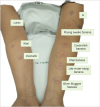1. Muraro A, Werfel T, Hoffmann-Sommergruber K, Roberts G, Beyer K, Bindslev-Jensen C, Cardona V, Dubois A, duToit G, Eigenmann P, Fernandez Rivas M, Halken S, Hickstein L, Høst A, Knol E, Lack G, Marchisotto MJ, Niggemann B, Nwaru BI, Papadopoulos NG, Poulsen LK, Santos AF, Skypala I, Schoepfer A, Van Ree R, Venter C, Worm M, Vlieg-Boerstra B, Panesar S, de Silva D, Soares-Weiser K, Sheikh A, Ballmer-Weber BK, Nilsson C, de Jong NW, Akdis CA. EAACI Food Allergy and Anaphylaxis Guidelines Group. EAACI food allergy and anaphylaxis guidelines: diagnosis and management of food allergy. Allergy. 2014; 69:1008–1025.


2. Ballmer-Weber BK. Food allergy in adolescence and adulthood. In : Ebisawa M, Ballmer-Weber BK, Vieths S, Wood RA, editors. Food allergy: molecular basis and clinical practice. Basel (Switzerland): Karger Publishers;2015. p. 51–58.
3. Macchia D, Melioli G, Pravettoni V, Nucera E, Piantanida M, Caminati M, Campochiaro C, Yacoub MR, Schiavino D, Paganelli R, Di Gioacchino M. Food Allergy Study Group (ATI) of the Italian Society of Allergy, Asthma and Clinical Immunology (SIAAIC). Erratum to: Guidelines for the use and interpretation of diagnostic methods in adult food allergy. Clin Mol Allergy. 2015; 13:31.



4. Sicherer SH, Sampson HA. Food allergy. J Allergy Clin Immunol. 2010; 125:2 Suppl 2. S116–S125.

5. Möhrenschlager M, Ring J. Food allergy: an increasing problem for the elderly. Gerontology. 2011; 57:33–36.


6. Motosue MS, Bellolio MF, Van Houten HK, Shah ND, Campbell RL. Increasing Emergency Department visits for anaphylaxis, 2005-2014. J Allergy Clin Immunol Pract. 2017; 5:171–175.e3.


7. Fernández-Rivas M, Benito C, González-Mancebo E, de Durana DA. Allergies to fruits and vegetables. Pediatr Allergy Immunol. 2008; 19:675–681.


8. Zuidmeer L, Goldhahn K, Rona RJ, Gislason D, Madsen C, Summers C, Sodergren E, Dahlstrom J, Lindner T, Sigurdardottir ST, McBride D, Keil T. The prevalence of plant food allergies: a systematic review. J Allergy Clin Immunol. 2008; 121:1210–1218.e4.


9. Anderson LB Jr, Dreyfuss EM, Logan J, Johnstone DE, Glaser J. Melon and banana sensitivity coincident with ragweed pollinosis. J Allergy. 1970; 45:310–319.


10. O'Keefe AW, Ben-Shoshan M. A 4-month-old baby boy presenting with anaphylaxis to a banana: a case report. J Med Case Rep. 2014; 8:62.


11. Moreno-Ancillo A, Domínguez-Noche C, Gil-Adrados AC, Cosmes PM. Allergy to banana in a 5-month-old infant. Pediatr Allergy Immunol. 2004; 15:284–285.


12. Linaweaver WE Jr, Saks GL, Heiner DC. Anaphylactic shock following banana ingestion. Am J Dis Child. 1976; 130:207–209.


13. Savonius B, Kanerva L. Anaphylaxis caused by banana. Allergy. 1993; 48:215–216.


15. Imamura T, Kanagawa Y, Ebisawa M. A survey of patients with self-reported severe food allergies in Japan. Pediatr Allergy Immunol. 2008; 19:270–274.


16. Hassan AK, Venkatesh YP. An overview of fruit allergy and the causative allergens. Eur Ann Allergy Clin Immunol. 2015; 47:180–187.

17. Grob M, Reindl J, Vieths S, Wüthrich B, Ballmer-Weber BK. Heterogeneity of banana allergy: characterization of allergens in banana-allergic patients. Ann Allergy Asthma Immunol. 2002; 89:513–516.


18. Hauswirth DW, Burks AW. Banana anaphylaxis with a negative commercial skin test. J Allergy Clin Immunol. 2005; 115:632–633.


19. Delbourg MF, Guilloux L, Moneret-Vautrin DA, Ville G. Hypersensitivity to banana in latex-allergic patients. Identification of two major banana allergens of 33 and 37 kD. Ann Allergy Asthma Immunol. 1996; 76:321–326.


20. Reindl J, Rihs HP, Scheurer S, Wangorsch A, Haustein D, Vieths S. IgE reactivity to profilin in pollen-sensitized subjects with adverse reactions to banana and pineapple. Int Arch Allergy Immunol. 2002; 128:105–114.


21. Palacin A, Quirce S, Sanchez-Monge R, Bobolea I, Diaz-Perales A, Martin-Muñoz F, Pascual C, Salcedo G. Sensitization profiles to purified plant food allergens among pediatric patients with allergy to banana. Pediatr Allergy Immunol. 2011; 22:186–195.


22. Sanchez-Monge R, Blanco C, Díaz-Perales A, Collada C, Carrillo T, Aragoncillo C, Salcedo G. Isolation and characterization of major banana allergens: identification as fruit class I chitinases. Clin Exp Allergy. 1999; 29:673–680.


23. Ring J, Messmer K. Incidence and severity of anaphylactoid reactions to colloid volume substitutes. Lancet. 1977; 1:466–469. Epub 1977/02/26. DOI:
10.1016/s0140-6736(77)91953-5.










 PDF
PDF Citation
Citation Print
Print



 XML Download
XML Download